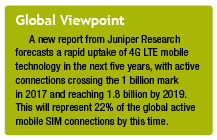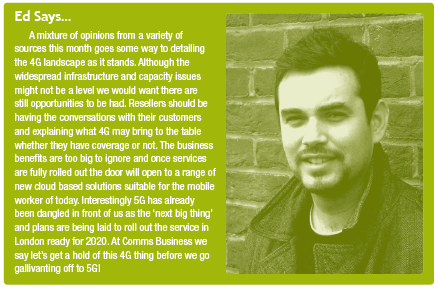
4G was heralded as the rebirth of mobile connectivity when operators first started talking about it years ago. It was going to be far superior to 3G and open doors that only superfast connectivity could open. Cloud technology, M2M and even the way we make calls were all going to change and create a new wave of commercial opportunities for resellers. Here, we take a look at the reality of 4G. Has it delivered all that it promised? Are our mobile connectivity woes a thing of the past? Has the Channel embraced this ‘new’ opportunity and has it enabled them to sell a whole new suit of solutions into their customer base? David Dungay investigates.
When I first approached this article I really wanted to get a sense of the 4G landscape as a whole and really get to the bottom of who is offering what and where. What became painfully obvious is from the get go is that network operators still have a long way to go until they achieve widespread coverage and everyone is playing catch up to the likes of EE.
Alexis Argent, founder and director of communications distributor, 4Gon Solutions commented “The 4G landscape is still in the process of being formed, with EE being first out of the gate. EE have done well to get where they stand, setting up the UK’s first 4G network a year ahead of the competition and only recently being chased for 4G dominance by the likes of O2 and Vodafone. This has proven to be an advantage as EE now have 4.2 million customers signed up to a 4G contract and 5,500 corporates using 4G. They still hold a comfortable lead over rivals Vodafone and O2, who both have just over one million customers signed to a 4G contract.”
Mark Curtis-Wood, Head of Network Services, Nimans said “The main metropolitan areas are where 4G tends to be found. So if people live in a major town or city they will be able to access 4G but for other people it’s a different story. If you are travelling around the country the service will inevitably disappear and revert to 3G. However if you have a business that operates in a city centre environment they are more likely to be layering additional services onto devices. Over 230 towns and cities can now gain access to 4G, which is more than 70% of the population.”
James Arnold Roberts, director at Genius Networks added “We’re very enthusiastic at Genius Networks about the roll out of 4G. Genius is one of the first aggregators to actually have it integrated into its network.
EE had a head start on other 4G players and the gap has not closed yet. Other operators are nervous about the risk of coping with that amount of data on their networks. High pricing is deliberately being used to limit the number of adopters and manage that capacity issue. This will improve once the operators build their networks up and unleash it.”
Mike Van Bunnens, Managing Director, Comms365 said “The UK 4G coverage is improving daily, yet it seems that the mobile operators have been slow to pick up on the business benefits of the technology. Wholesale opportunities for 4G have been considerably slower to emerge than the consumer offering, but this is more likely due to the mobile operators’ ‘volume subscriber connections’ mentality. You can understand the operators’ need to see a return on the roll out investment, but at the same time, ignoring the business community (where longer term, lower churn agreements can be made) is missing the bigger picture. Admittedly, connection numbers won’t match handset subscribers, but data usage will be greater.”
Hype versus Reality
As an industry we have been talking about 4G for quite some time now and although some people have access to services there are many that don’t or just simply aren’t using it. Has the excitement factor gone from 4G already or perhaps people are a little wary of new technology until it is thoroughly tried and tested?
Curtis-Wood says “I think it is living up to the hype, subject to where it is available. If you can get it, it’s really good but if not, just like any form of connectivity, it’s really frustrating. There’s still pockets and parts of the UK that can’t get superfast broadband, or over 2meg on a data line. Does that stop the wider acceptance? No. What you find is that people will gravitate to those geographical areas where they can access it. Some people will do their research and relocate accordingly.”
Matthew Skipsey, Technical Sales Manager at M12 disagrees, “I have been on 4G since November and it’s made little difference to my work, sad to report. I am a big mobile user, and frequently need to use mobile data on my iPhone, iPad (4G sim enabled) and laptop (tethered via iPhone or iPad). I need it the most on the trains, and the coverage is diabolical and patchy.
 The Vodafone 4G speed improvement is better than the Vodafone 3G, however 3G via my H3G SIM on my iPad is often faster, and more reliably faster, than Vodafone in most circumstances and locations. Overall, 4G is a lot of hype in my opinion at the moment.”
The Vodafone 4G speed improvement is better than the Vodafone 3G, however 3G via my H3G SIM on my iPad is often faster, and more reliably faster, than Vodafone in most circumstances and locations. Overall, 4G is a lot of hype in my opinion at the moment.”
Argent added, “The technology has been a little slow to get off the ground, with EE only recently facing some competition, but the figures show that customers and businesses are now starting to make the most of 4G. Enthusiasm for the technology is still building as more people are signing up for 4G contracts over 3G, and EE are on target to have 6 million customers by the end of the year. However, this rapid growth has not occurred without strain on the network. RootMetrics have claimed that the rate of EE’s 4G speeds is slowing as a result of more concurrent users. To combat this, EE has introduced a double-speed 4G network to keep away from the age of buffering, finding 1 in 3 new customers signing up to this service.
With so many developments in the works, we can’t overlook the downsides to 4G. While inner cities have the infrastructure in place, rural areas and suburbs suffer from a lack of coverage. The fact that many places will still find your mobile falling back to 3G or a slower connection is what currently stands in the way of previous technologies becoming obsolete.”
Van Bunnens added “From a business perspective, the excitement should actually be increasing as more options are becoming available through the niche providers. Forget phones, the future of grown-up 4G involves enterprise routers capable of delivering secure immediate data access, disaster recovery and office communications as an all-in-one.”
Graham Sutherland, CEO, BT Business, said: “Our research shows that 24% of employees now work regularly out of the office. As part of our strategy to offer a portfolio that provides value for money and meets the changing needs of businesses, we’ve designed our new mobile plans to cater for this. Our new plans give customers the connectivity they need to help them stay productive when out and about, along with the flexibility to choose a plan that suits their way of working.” 
Tipping Point
Curtis-Wood thinks the biggest changes will come when we reach ‘tipping point’ with 4G services, “I think there’s still some way to go before we get full penetration and true uptake and acceptance of 4G. It was just the same with 3G. Once it started to hit critical mass that’s when key business decisions started to be made. If a company has a team of 10 people and they are geographically dispersed and 9 of them can get 4G then a business will roll out a specific feature or application. The tipping point hasn’t been reached yet. However when it does people will notice a big difference compared to 3G because building penetration is much greater due to the spectrums being used. Therefore there’s going to be much greater access inside offices as well as outside.”
Argent added, “Those who run hospitality and temporary outdoor events are also benefitting greatly from 4G technology. In these situations, using a 4G system is cheaper to install than the fixed line or WiFi alternatives. Furthermore, 4G can also be used by resellers to provide security systems to a site, connecting IP video surveillance systems to a cellular network.”
In the Field – A dealer perspective
We asked our dealers what they thought of 4G as they are out there selling this stuff all year round. A dealer that wished to remain nameless commented, “So far I have had a mixed experience. The one customer I have who really benefits from 4G is my least data-savvy one. Staff continually email large attachments to each other and rarely start new emails strings. In other words they habitually email ‘war and peace’. To compound this they do not have WiFi in their offices nor seek out free Hotspots when on the move. So, whilst they may waste money on mobile data, at least with 4G they don’t have to waste time.
It seems to me that the networks’ efforts to persuade business users to switch to 4G are not as co-ordinated or as imaginative as they as they might be:
On many devices it is actually difficult to use mobile data for chunky downloads, e.g. an App update, as the device will insist that WiFi is used
The networks so far seem to have few ideas how business users benefit from 4G. Case studies always seem to show estate agents video new properties and uploading the pictures without having to return to the office but that’s about it. Other practical suggestions how fast mobile data can improve working lives or deliver competitive edge are very few.
I believe that 4G can do great things for business but before it is of real value to the majority there need to be tweaks to the technology and, more importantly, far more user-training (so that users feel comfortable using voice memos, video calling, scanning receipts rather than keeping paper, remotely collaborating on projects, accessing cloud based files rather than emailing them and all the other things that we can but don’t do with smart phones) and work-design around remote rather than office-based working. I am quite excited by this as it provides me an opportunity really to be a telecommunications solution-provider rather than box salesman by offering work-design and user-training along with smartphones.”
Channel Impact
So what does it all mean for the Channel? We asked our contributors how 4G could empower resellers and dealers to grow their businesses.
Curtis –Wood said “4G creates opportunities for more revenue streams. It enables true mobility. Once people start to enjoy superfast connectivity there’s much more they can do with a smartphone or tablet device when they are on the move. Taking their desktop on the road and gaining access to cloud services will all become more prevalent. Utilising video conferencing on a mobile phone for example is going to become a much more realistic proposition when a device is 4G enabled.”
Andrew Wilford, Product Director for Mobile at Daisy Wholesale comments “4G will be a key driver for mobility and flexible working and resellers must be prepared for this. Modern businesses need to have the option of operating from anywhere at any time, and cloud enables this. That is why it has never been as important for resellers to own their end users’ connectivity and be able to offer them a range of products and services delivered through the cloud.
Teaming 4G with enhanced cloud-based service delivery and the continued hype of consumerisation within the workplace such as BYOD, it is an opportunity that resellers cannot miss. Without the connectivity, they will fail to truly take advantage of cloud and the future prospects that it has to offer. “
Van Bunnens added, “The reseller opportunity is clear. Customers are investing more in cloud services than ever before. That investment requires always-on connectivity. Fixed line services are relied on to deliver everything, yet there is now a backup technology that can deliver the type of performance that is required should the worst happen. Offering a scalable (by that we mean a single 4G connection, or multiple, bonded 4G connections depending on size of operation) solution in conjunction with traditional wired connections will not only improve SLA performance, it will enhance the service proposition and reduce churn.”
Dazed and Confused?
We all like to get caught up in the latest and greatest technology and 4G is no different. New technology will never be adopted if users don’t understand the benefits in the context of the bigger picture. This is where the Channel can really get stuck into their customers and play that trusted advisor role.
Van Bunnens asks a pertinent question, “Much has been written about 4G and the benefit to consumers with regards to the ‘positive’ impact to the user experience on mobile devices, but do businesses understand that the increase in throughput can also have a positive impact on their day to day communications infrastructure?”
Wilford agrees “As the major mobile networks continue to increase the coverage of 4G connectivity, there are many still unsure of how to harness the advancing technology in order to improve business efficiency. “

